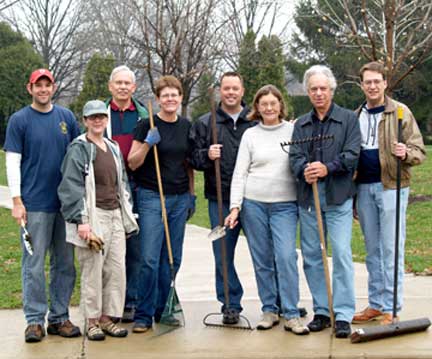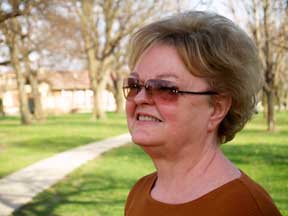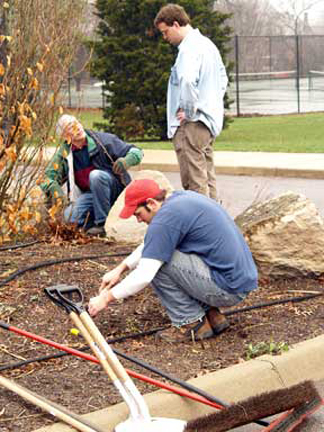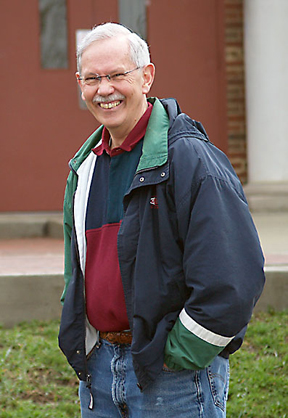
Columbus, Ohio USA
Return to Homepage www.shortnorth.com
Friends of Goodale Park
Twenty Years of Bloomin' Hard Work
April 2007
by Jennifer Hambrick
Return to Features Index
Return to Neighborhood Organizations© Photos/Rick Borgia
Friends from left: Rick Frantz, Denise Weinberg, Stan Sells, Amy Kobe, Michael Dutcher, Valerie and Dave Cressy, Ian Stewart Going from rags to riches. Phoenix rising from the ashes. Raising Lazarus from the dead. It doesn’t matter what cliché you apply to the work of the Friends of Goodale Park: they all fit. Though the park began as an idyllic gift to the city more than 150 years ago, its more recent decline into neglect turned Goodale Park from a bounty into a blight. Over the last 20 years, and as a labor of love, the Friends of Goodale Park have turned the park around. It would not be the urban oasis it is today were it not for the Friends, who voluntarily nursed it back to health when it had fallen into neglect and who have worked tirelessly to make it an inviting place to visit. And the Friends say they’re just getting started.
Goodale Park Then
When Goodale Park became Goodale Park in 1851, it was virtually in the boondocks. All of what was at the time Columbus was to the park’s south, and a trip to the park was an arcadian escape from city life.
Goodale Park looked different back then from how it looks today. There were two lakes, not one, and a boathouse to go with them. And originally there was only one set of gates, whose stone columns and wrought iron grilles stood with fortress-like solidity at the main park entrance on Goodale Street.
The three other entryways the park now has are a testament to the development of Neil Avenue into a trendy, upscale neighborhood.
“The park used to be the northernmost developed part of the city, so all of the traffic came from the south. As the neighborhood developed along Neil, that’s when the other (three) entrances were created,” said Don Damron, a Friend of Goodale Park.
A circular carriage trail used to run around the inside edge of the park, connecting all four sets of gates. Respite from the toils of city life were easy to be had on an afternoon ride around Goodale Park.
The park’s pastoral splendor slowly faded away from neglect in the first half of the twentieth century, as the city expanded.
“Back in the late 1800s and early 1900s Victorian Village was the place to be, but then when they invented automobiles, people were driving out and the suburbs were developing and the downtown was deteriorating,” said Friends of Goodale Park Vice President Pat Lewis.
The park languished through the 1970s and most of the 1980s, even as people were restoring Columbus’ historic neighborhoods.
“German Village started cleaning up and people started to realize that the other neighborhoods could too,” Lewis said. “In the 1970s people started seeing the potential of the Victorian Village old homes.
Friends Vice President Pat Lewis In 1974 the Victorian Village Society started and we got a newsletter (started) and we gave tours. People came down and saw that there were homes with people living in them who had good jobs and some money. (But) people were spending all their money and time redoing the homes. They didn’t have any extra energy or money to put into the park.”
Though Lewis, a Victorian Village resident, says the park is her “front yard,” she says she rarely visited it during those days.
“I probably did not set foot in the park for ten years because it was such a nasty-looking place,” Lewis said.
“It was kind of scary and unattractive. There were nasty-looking bushes, weeds. We had to jump up and down to get it on a mowing schedule. The grass was up to our ankles when you walked in it. There were people sleeping under trees, panhandlers.”
For many Victorian Village residents in the 1980s, Goodale Park may have been more of an eyesore than an idyll. The neighborhood got a wake-up call in the mid-1980s, when the Columbus Recreation and Parks Department began installing in Goodale Park tracks for the train that had once run through the Columbus Zoo.
“The neighbors started noticing these train tracks being laid around Goodale Park,” Lewis said, “and the neighbors started screaming, ‘We don’t want these trains in the park.’
We had a huge meeting in the shelter house, people standing on their chairs and yelling.”
This gathering of protesters may have been the first unofficial meeting of what would become the Friends of Goodale Park. The group’s official first meeting took place in 1987 after a windstorm took down hundreds of the park’s trees.
“We realized that we had to make some effort to take responsibility for the park,” said Stan Sells, a founding member and currently president of the Friends of Goodale Park. “The City was not going to be able to do it on its own.”
L to R: Friends President Stan Sells, Rick Frantz,
and Greg Maynard (standing).A Field of Dreams
After Barbara Covert led the successful campaign against the train tracks, Ronda Griffith-Grubb briefly took over as leader of the park activists. Griffith-Grubb was succeeded in 1987 by Norm Dolder, who remained president of the Friends of Goodale Park for 15 years.
Dolder’s first act as president was to install the gazebo by the lake with funds from the Columbus Department of Recreation and Parks and a grant from the Columbus Founda-tion. Lewis says the Friends next installed Victorian-style lighting fixtures and seating in the park and restored the Goodale Park caretaker’s residence, attached to the shelter house.
“Back in the early to mid part of the (twentieth) century the person who took care of that park actually lived in the park,” Lewis said.
In the 1940s, responsibility for the park was turned over to the City of Columbus, which rented the house to a retired police officer during the 1960s, ’70s and ’80s. The residence sat vacant for several years after the officer’s death. In the mid-1990s the City sold the house to the Friends of Goodale Park for one dollar.
The Friends began renovation work on the residence in the late 1990s, having received grants from the Columbus and Rheinberger Foundations for work on the exterior and interior of the building. The Friends completed the renovation work in 2001. The building now houses the offices of the Short North Business Association and the Short North Special Improvement District and makes a large meeting room available to the Friends and other area organizations.
Park improvements continued when Sells became president in 2002. Sells says City and grant funding has long empowered the Friends to carry out their vision for the park. In 2006, the Friends received an Urban Infrastructure Funding (UIRF) grant from the Columbus Department of Recreation and Parks. The grant enabled the Friends to upgrade and replace many deteriorating park sidewalks, build terraces around the park shelter house and begin to renovate the playground area.Sells says another UIRF grant, in the amount of $275,000, will enable the Friends to finish some of the projects started in the previous grant cycle and begin work on other improvements. Sells says the Friends of Goodale Park will complete the shelter house terrace project by adding brick columns with lighting on either side of the terrace stairways and wrought iron fencing joining the columns. Amenities such as swings, climbing equipment, bike racks and seating will be added to the playground area. An inoperable spray pool will be removed from the playground and replaced with several game tables for playing chess or checkers.
“The focus is on making the playground area a more pedestrian-friendly area,” Sells said.
The current UIRF grant will fund the restoration of the six sandstone columns that comprise the historic Goodale Gate. The wrought iron core of each column has expanded over the years, damaging the stone around it.
“These gates date back to 1870, so they’ve been around for a while and are probably one of the oldest stone structures in the city at this point, so we’d very much like to preserve them,” Sells said.
At an estimated cost of $54,000, the Goodale Gate renovation cannot be completed solely under the UIRF grant. The Friends have applied for a supplemental grant from the Columbus Foundation.
The Friends also plan, under the 2007 UIRF grant, to have designs drafted for improvements to the nondescript entryway at the park’s southeast corner.
“It’s very unattractive, very uninviting, and we would very much like to add a nice pedestrian entrance at that corner,” Sells said. Future grant funding, Sells hopes, would enable the Friends to implement the selected design.
As important as funding is in implementing the Friends’ plans, there would be no plans to implement without the Friends themselves. Routine park maintenance and seasonal flower planting are all the work of volunteers, and are sometimes supported only by very small grants for supplies. Sells says there are many other ways to contribute to the park.
“Rec and Parks has not fared well under budget allocation, so they’ve been in a cut-back mode for some time, which means that maintenance in the park, particularly around flower beds, is really dependent on volunteers,” Sells said. “I’ve been guilty of conveying that participation in the park is limited to planting flowers and weeding flower beds. There are lots of other opportunities to get involved if you’re not wanting to get your hands dirty.”
Working with other volunteers over a period of two years, Goodale Park Friend Rick Frantz, an arborist by training, recently completed an inventory of the trees in Goodale Park.
Frantz, who works in the Geographic Information Systems Department of the City of Dublin and also part-time as an urban forestry specialist for the City of Powell, says he saw a need to detail precise information and vital statistics of the park’s many unusual tree varieties.
“I knew that there were unusual trees in the park, and I didn’t know if anyone really had a handle on what was there,” Frantz said. “The City of Columbus had a list of what was in the park, but that really wasn’t shared with anyone. My intent with the inventory was to make that information more available.”
The locations of all of Goodale Park’s 662 trees have been precisely mapped with GPS equipment (loaned at no cost by the City of Dublin) and recorded in a database inventory. Each tree’s location, as well as information such as its genus, species, size, condition, whether or not it should be pruned and structural problems it may be having, have been entered into a database that will be updated every five years.
Sells says the inventory will make the Friends’ tree-planting decisions a little easier.
“When we’ve said we want to add a tree at a particular spot, without having an inventory of the trees in the park, it’s been sometimes difficult to know what should be added.”
Frantz says a database with information about the park’s trees will be made available to the public through the Web, at the Goodale Park site.
“The value to the public is that if they have the foresight to ask what the trees were in the park, then maybe they could decide, I really like that tree, look up what that tree is, and maybe plant one of their own. Or maybe they have that tree in their yard and can see what it will look like when it’s mature, to kind of head off problems proactively. And to make people aware of what an important resource the park is, with the tree species that are there, that are found nowhere else in Columbus.”
Frantz hopes to make information about the park’s unusual trees available in a map that people could take with them on tree tours of the park.
Stan Sells The Future of the Park
Although the Friends of Goodale Park have surveyed Victorian Village residents to learn what they see as the most pressing park issues, they hope to get even more input from the community about improvements they should implement in the future.
Sells says many traffic and park usage issues, including the threat of valet parking, dog use of the park and internal circulation around the park still need to be addressed.
“We’re seeing a number of valet parkers use that driveway through the park as a cut-through to get to parking spaces and to avoid having to do longer runs through the neighborhood,” Sells said. “What we see is that the valet parkers drive through there are a high rate of speed, so it’s not something we want to encourage.”
The Friends have discussed placing a bollard – a removable ornamental post – that would prevent car traffic from entering the park at the Goodale Gate.
Sells says more public discussion is needed to determine whether dogs should be able to run free in Goodale Park.
“This issue that has been apparent for a while is that we do have a fair number of dog owners who use the park for letting their dogs run, and as it currently works out, they often gather at the center of the park, which is where some of the major sidewalks that cross through the park converge. For pedestrians who are going through the park, sometimes there is a conflict with dogs coming up and jumping on you. Even though the City statute says the dog must be under voice control, the reality is that often they are not. So there are issues of conflict between dog owners and non-dog owners who are using the park at the same time.”
Among other possibilities, the Friends are considering the viability of finding another Short North area green space that could serve as a dog park.
And in a nod to the park’s early history, the Friends have discussed bringing back the old circular carriageway around the park.
“At the moment there is no internal circulation option within the park,” Sells said. “You can walk through the park, but there’s no pathway that allows you to do a walk within the park.
One of the things we’d like to look at is, is there a possibility of developing some kind of internal circular pathway that would allow people to come and take a nice walk throughout the park?”
The Friends also are still working to secure funding that would enable them to realize Malcolm Cochran’s design for Tête à Tête Falls for the park’s pond. Progress in securing funding has been slow, as no corporate sponsors have yet agreed to support the project. However, in response to the death of architect and Friend of Goodale Park Paul Cianelli, a group has offered to raise 25 per cent of the necessary funding for the project as a memorial to Cianelli. Sells says the Friends still need to raise a total of $250,000, and that they will be applying for grants to bring the project to fruition.
“At the moment we are about three-fourths of the way there to our goal. We’re making progress, but we’re not there yet,” Sells said.
All of these pending and future projects are part of a developing master plan for Goodale Park. The Friends continue to work on a project-by-project basis while the master plan is being devised. Whatever the plan may eventually contain, the Friends want it to reflect the interests of the community.
“We would like the master plan to incorporate more community input,” Damron said. “The park planning process is very open to suggestions and public input. Before we adopt any plan that has major improvements in it, we would certainly take it to the neighborhood to get some public input.”
And seeing the value of a neighborhood park is what inspires Sells and so many of the Friends of Goodale Park to take it under their wings.
“I view the park as a real gem in our midst,” Sells said. “It’s really a very beautiful urban space, so I’ve been committed to trying to make it an even more attractive urban space for our particular neighborhood. It’s one of the key elements that helps make the Short North what it is.”Call Stan Sells at 614-299-4202 for more information or visit www.friendsofgoodalepark.org
© 2007 Short North Gazette, Columbus, Ohio. All rights reserved.



